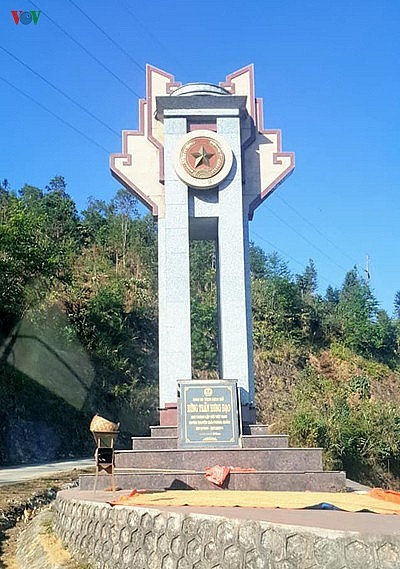Visitors to the 200-hectare Tran Hung Dao forest are enticed by its stunning beauty.They are welcomed at the entrance by a giant bas-relief featuring 34 soldiers attending a ceremony on December 22, 1944, to inaugurate the Vietnam Propaganda and Liberation Army, the predecessor of today’s Viet Nam People’s Army.
Tour guide Hong Hanh explained, “The bas-relief was crafted in 2004 to celebrate the 60th anniversary of the Vietnam People’s Army. At the center of the art work is General Vo Nguyen Giap and 34 soldiers at the launch ceremony, sheltered by a canopy of evergreen trees. They are flanked by local citizens and members of the interprovincial Party Committee of Cao Bang, Bac Kan, and Lang Son province.”
A cement path, shaded by ancient trees, leads to the spot where the Vietnam Propaganda and Liberation Army was born. The tree on which the national flag, a five-pointed gold star in the center of a red background, was hoisted at that ceremony still stands there.
Hong Hanh elaborated, “There is a stele to commemorate the creation of the Vietnam Propaganda and Liberation Army. In October, 1944, Ho Chi Minh returned to Vietnam after a year’s imprisonment in China. He was briefed by General Vo Nguyen Giap on recent revolutionary activities in Cao Bang, Bac Kan, and Lang Son province and a decision to revolt by the interprovincial Party Committee.”
“Ho Chi Minh ordered a delay of the revolt and the formation of the Vietnam Propaganda and Liberation Army. General Giap delivered a speech highlighting the Army’s missions and responsibilities at the launch ceremony at 5pm on December 22, 1944,” she added.
Later a huge stele was erected there, inscribed with Ho Chi Minh’s order to form the Vietnam Propaganda and Liberation Army, the ten-point oath of honor read by General Giap, and the names of the 34 soldiers who attended the ceremony.
Next to the stele is a rest area containing sleeping huts and eating pavilions used by Vietnamese troops during the war. Beyond that 505 steps lead to the top of Den Sinh mountain.
“This peak, called Sam Cao, was an observation point from which General Giap planned his first attack. From here, he had a bird’s eye view of a nearby village, a French military post, a sheltering cave, and transportation routes to other posts and Bac Kan province,” tour guide Hanh said.
The nearby village and French military post, both called Phai Khat, were where the Vietnam Propaganda and Liberation Army fought its very first battle. The post was set up at a local house.
Nong Van Danh, a grandchild of the house’s owner, said, “This house, spanning 210 square meters, is in the middle of Phai Khat village. It was a strategic location that blocked the entrance to the entire commune and provided easy access to Nguyen Binh district, so it was seized by the French in early 1944 to dampen the local revolutionary movement. A careful study of the routes in and out of the post helped our poorly-armed soldiers succeed in regaining control of the house.”
“This was only a small achievement but it filled our liberation soldiers with faith in the ultimate victory of their resistance war and gave them first-hand combat experience,” Danh added.
The Phai Khat military post is now an exhibition house showcasing documents and artefacts of the inauguration ceremony of the Vietnam Propaganda and Liberation Army.
Just 500 meters from the post is a cave where, on a large flat rock, Vietnamese soldiers mapped out attacks on Phai Khat and another post 20 kilometers away called Na Ngan, both of which were successfully captured.
Tran Hung Dao forest was recognized as a special national relic in 2014 on the70th anniversary of the Vietnam People’s Army.




